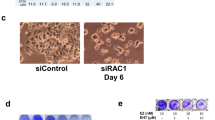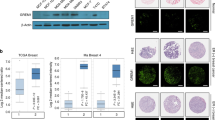Abstract
Overexpression of the ERBB2 proto-oncogene in breast tumours, which occurs in 25–30% of patients, correlates with poor prognosis. In oestrogen receptor (ER) positive breast epithelial cells oestrogens reduce ERBB2 mRNA and protein levels, an effect that is reversed in the presence of anti-oestrogens such as tamoxifen and ICI 182780. Our previous studies have shown that the major effect of oestrogen on ERBB2 expression is at the level of transcription and that this is mediated through a region within the ERBB2 first intron which can act as an oestrogen-suppressible enhancer in ER positive breast cells. In vitro footprinting of the smallest DNA fragment that retained full activity revealed four transcription factor binding sites. We report here that two of these sites are recognized by AP-2 proteins and the other two are bound by a variety of bZIP factors, including CREB and ATF1, with a major complex containing ATFa/JunD. However, by using ER mutants it is clear that repression occurs essentially off the DNA. Indeed, the essential domain of the ER responsible for repression of the ERBB2 enhancer is a region termed AF2 which is required for the ligand-dependent association of non-DNA binding cofactors. We further demonstrate that one of these ER cofactors, SRC-1, can relieve oestrogen repression of the ERBB2 enhancer and conclude that these data fit with a model whereby the ER and the ERBB2 enhancer compete for this limiting, non-DNA binding cofactor. Thus, in oestrogenic conditions SRC-1 preferentially binds to the ER which effectively sequesters it thereby reducing enhancer activity, but in anti-oestrogenic media the cofactor is released from the ER and is therefore available to activate the ERBB2 enhancer.
This is a preview of subscription content, access via your institution
Access options
Subscribe to this journal
Receive 50 print issues and online access
$259.00 per year
only $5.18 per issue
Buy this article
- Purchase on Springer Link
- Instant access to full article PDF
Prices may be subject to local taxes which are calculated during checkout






Similar content being viewed by others
References
Antoniotti S, Tavema D, Maggiora P, Sapei ML, Hynes NE and DeBortoli M. . 1994 Br. J. Cancer 70: 1095–1101.
Anzick SL, Kononen J, Walker RL, Azorsa DO, Tanner MM, Guan XY, Sauter G, Kallioniemi OP, Trent JM and Meltzer PS. . 1997 Science 277: 965–968.
Bates NP and Hurst HC. . 1997 Oncogene 15: 473–481.
Benbrook DM and Jones NC. . 1994 Nucleic Acids Res. 22: 1463–1469.
Berns EMJJ, Vanstaveren IL, Klijn JGM and Foekens JA. . 1998 Br. Cancer Res. Treat. 48: 87–92.
Bevan CL, Hoare S, Claessens F, Heery DM and Parker MG. . 1999 Mol. Cell. Biol. 19: 8383–8392.
Bocco JL, Bahr A, Goetz J, Hauss C, Kallunki T, Kedinger C and Chatton B. . 1996 Oncogene 12: 1971–1980.
Bosher JM, Williams T and Hurst HC. . 1995 Proc. Natl. Acad. Sci. USA 92: 744–747.
Bosher JM, Totty NF, Hsuan JJ, Williams T and Hurst HC. . 1996 Oncogene 13: 1701–1707.
Bouchard L, Lamarre L, Tremblay PJ and Jolicoeur P. . 1989 Cell 57: 931–936.
Brzozowski AM, Pike AC, Dauter Z, Hubbard RE, Bonn T, Engstrom O, Ohman L, Greene GL, Gustafsson JA and Carlquist M. . 1997 Nature 389: 753–758.
Caelles C, Gonzalezsancho JM and Munoz A. . 1997 Genes Dev. 11: 3351–3364.
Carey M. . 1998 Cell 92: 5–8.
Chatton B, Bocco JL, Goetz J, Gaire M, Lutz Y and Kedinger C. . 1994 Oncogene 9: 375–385.
Danielian PS, White R, Lees JA and Parker MG. . 1992 EMBO J. 11: 1025–1033.
Dati C, Antoniotti S, Tavema D, Perroteau I and De Bortoli M. . 1990 Oncogene 5: 1001–1006.
Di Fiore PP, Pierce JH, Kraus MH, Segatto O, King CR, and Aaronson SA. . 1987 Science 237: 178–182.
D'Souza B, Berdichevsky F, Kyprianou N and Taylor-Papadimitriou J. . 1993 Oncogene 8: 1797–1806.
Gee JMW, Robertson JFR, Ellis IO, Nicholson RI and Hurst HC. . 1999 J. Pathol. 189: 514–520.
Heery DM, Kalkhoven E, Hoare S and Parker MG. . 1997 Nature 387: 733–736.
Hollywood DP and Hurst HC. . 1993 EMBO J. 12: 2369–2375.
Hurst HC. . 1996 In: Protein Profiles, 3. Sheterline P (ed.).. Academic Press: London.
Hurst HC, Masson N, Jones NC and Lee KAW. . 1990 Mol. Cell. Biol. 10: 6192–6203.
Kalkhoven E, Valentine JE, Heery DM and Parker MG. . 1998 EMBO J. 17: 232–243.
Kamei Y, Xu L, Heinzel T, Torchia J, Kurokawa R, Gloss B, Lin SC, Heyman RA, Rose DW, Glass CK and Rosenfeld MG. . 1996 Cell 85: 403–414.
Kim HJ, Kim JH and Lee JW. . 1998 J. Biol. Chem. 273: 28564–28567.
Lahooti H, White R, Danielian PS and Parker MG. . 1994 Mol. Endocrinol. 8: 182–188.
Lee SK, Kim HJ, Na SY, Kim TS, Choi HS, Im SY and Lee JW. . 1998 J. Biol. Chem. 273: 16651–16654.
Lee K-F, Simon H, Chen H, Bates B, Hung M-C and Hauser C. . 1995 Nature 378: 394–398.
Livingstone C, Patel G and Jones NC. . 1995 EMBO J. 14: 1785–1797.
Marchionni MA. . 1995 Nature 378: 334–335.
McKenna NJ, Lanz RB and O'Malley BW. . 1999 Endocrine Reviews 20: 321–344.
Merika M, Williams AJ, Chen G, Collins T and Thanos D. . 1998 Mol. Cell. 1: 277–287.
Na SY, Lee SK, Han SJ, Choi HS, Im SY and Lee JW. . 1998 J. Biol. Chem. 273: 10831–10834.
Nass SJ, Hahm HA and Davidson NE. . 1998 Nature Medicine 4: 761–762.
Newby JC, Johnston SRD, Smith IE and Dowsett M. . 1997 Clin. Cancer Res. 3: 1643–1651.
Onate SA, Tsai SY, Tsai MJ and O'Malley BW. . 1995 Science 270: 1354–1357.
Pietras RJ, Arboleda J, Reese DM, Wongvipat N, Pegram MD, Ramos L, Gorman CM, Parker MG, Sliwkowski MX and Slamon DJ. . 1995 Oncogene 10: 2435–2446.
Read LD, Keith D, Slamon DJ and Katzenellenbogen BS. . 1990 Cancer Res. 50: 3947–3951.
Revillion F, Bonneterre J and Peyrat JP. . 1998 Eur. J. Cancer 34: 791–808.
Slamon DJ, Clark GM, Wong SG, Levin WJ, Ullrich A and McGuire WL. . 1987 Science 235: 177–182.
Saatcioglu F, Claret FX and Karin M. . 1994 Semin. Cancer Biol. 5: 347–359.
Torchia J, Rose DW, Inostroza J, Kamei Y, Westin S, Glass CK and Rosenfeld MG. . 1997 Nature 387: 677–684.
Turner BC, Zhang, Gumbs AA, Maher MG, Kaplan L, Carter D, Glazer PM, Hurst HC, Haffty BC and Williams T. . 1998 Cancer Res. 58: 5466–5472.
Voegel JJ, Heine MJ, Zechel C, Chambon P and Gronemeyer H. . 1996 EMBO J. 15: 3667–3675.
Warri AM, Laine AM, Majasuo KE, Alitalo KK and Harkonen PL. . 1991 Int. J. Cancer 49: 616–623.
Acknowledgements
We would like to thank the following for the generous supply of clones, reagents and information: Alan Wakeling (ICI 182780); Bruno Chatton (ATFa antibodies and constructs); Nic Jones (ATF2 antibodies and constructs); David Gillespie (JunD constructs), Paul Meltzer (AIB1 construct) and Els Berns (data on SRC-1 levels in breast cell lines). We also acknowledge comments on the manuscript from Nick Lemoine and Jyrki Eloranta.
Author information
Authors and Affiliations
Rights and permissions
About this article
Cite this article
Newman, S., Bates, N., Vernimmen, D. et al. Cofactor competition between the ligand-bound oestrogen receptor and an intron 1 enhancer leads to oestrogen repression of ERBB2 expression in breast cancer. Oncogene 19, 490–497 (2000). https://doi.org/10.1038/sj.onc.1203416
Received:
Revised:
Accepted:
Published:
Issue Date:
DOI: https://doi.org/10.1038/sj.onc.1203416
Keywords
This article is cited by
-
Survival outcomes in HER2-low versus HER2-zero breast cancer after neoadjuvant chemotherapy: a meta-analysis
World Journal of Surgical Oncology (2024)
-
Combination of mTORC1/2 inhibitor vistusertib plus fulvestrant in vitro and in vivo targets oestrogen receptor-positive endocrine-resistant breast cancer
Breast Cancer Research (2019)
-
Membrane-bound estrogen receptor alpha initiated signaling is dynamin dependent in breast cancer cells
European Journal of Medical Research (2018)
-
Targeting tumour re-wiring by triple blockade of mTORC1, epidermal growth factor, and oestrogen receptor signalling pathways in endocrine-resistant breast cancer
Breast Cancer Research (2018)
-
Steroid receptor coactivators, HER-2 and HER-3 expression is stimulated by tamoxifen treatment in DMBA-induced breast cancer
BMC Cancer (2012)



